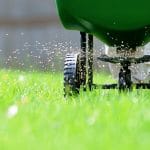 No matter the region or climate, fertilizer is frequently used to help keep residential lawns looking healthy. Fertilizer promotes thick, hardy grass growth by providing appropriate nutrients.
No matter the region or climate, fertilizer is frequently used to help keep residential lawns looking healthy. Fertilizer promotes thick, hardy grass growth by providing appropriate nutrients.
A secondary advantage to fertilizing your grass is that weeds are less likely to propagate in a dense, thriving ground cover.
But when it comes to dealing with chemicals, you want to be sure you’re doing the job properly in order to promote growth and avoid damaging your lawn.
How do you Know if you are Fertilizing your Lawn Properly?
A bag of fertilizer is labeled with three numbers that represent the percentages of weight of some of the key ingredients that plants will need.
For instance, all grasses need varying amounts of nitrogen, phosphorous and potassium.
If a bag is labeled 12-6-6, that means it bag contains twelve percent nitrogen, six percent phosphorous, and six percent potassium. All of these nutrients are important for verdant grass growth.
Here is how each nutrient is benefiting your North Texas lawn:
- North Texas lawns need nitrogen for top growth
- North Texas lawns need phosphorous for strong roots
- North Texas grass needs potassium for disease resistance
But What is the Best Ratio for Summer Fertilization?
Nitrogen-rich fertilizer is what works best with most North Texas grasses. 20-8-8 is a healthy ratio for the summer. In fact, some grasses don’t need the other two nutrients at all most times of the year. Be sure to check with an expert when purchasing fertilizer, to guarantee you’re coming home with the right product.
Other Important Things to Know About Fertilizer:
Fertilizer also has filler. So if you are looking at a bag that has 20-10-20 that adds up to 50. Which means there is 50 more percent of filler in the bag. Filler has no nutrients in it, but it’s important to also note that most bags come with filler.
The difference between fertilizers two important types- slow release and quick release:
Slow release:
- Affects lawns for 3 to 10 weeks.
- Produces steady, constant growth.
- Less likely to cause chemical burns in extreme heat.
- Slow release is granular with an outer coating, allowing it to soak in more slowly.
Quick release:
- Affects lawns for 1 to 3 weeks.
- Liquid fertilizer is always quick release.
Using organic lawn fertilizer is also an option in North Texas to manage lawn care. Usually with organic types, the nitrogen is also slow releasing and contains less than the regular type.
Another thing to consider when using organic fertilizer is that, since the levels of nitrogen is lower, a bag may read something like this: Nitrogen 5-3-2 instead of 20-10-20. That means you’ll need to use much more of the organic product due to the lower percentage of nutrients. This is a good thing to keep in mind regarding cost-efficiency.
Calculating How Much Fertilizer to Use:
- Determine size of lawn in square feet.
- Find square feet by multiplying the length of yard by width.
- Determine grass type.
- North Texas grass is usually Bermuda or St. Augustine, Zoysia or Tall Fescue. (In shady areas, you will often find Zoysia and Fescue).
- If you have St. Augustine or Bermuda grass, calculate 4/5 pounds of Nitrogen per year to be used on your grass.
- Potassium per year is about 1.5 pounds.
- Phosphorous is about 2.5 pounds per year.
One you determine how many pounds of fertilizer you need, divide it up between treatments. You want to treat from April to August. Let’s use April 15th for an example. Calibrate your spreader if you use one to be sure you use the right amount of fertilizer. If you are using slow release, it will give you a slow release from five to six weeks. You will have a healthy yard all year round.
 Keeping a lawn in North Texas can be easy or difficult, depending on how you take care of it. When to fertilize your lawn in North Texas is so important to follow all steps for the best looking lawn possible. Click here for more info on our lawn fertilization services!
Keeping a lawn in North Texas can be easy or difficult, depending on how you take care of it. When to fertilize your lawn in North Texas is so important to follow all steps for the best looking lawn possible. Click here for more info on our lawn fertilization services!

Thanks for pointing out that the amount of fertilizer I would need would be determined by the kind of grass in my lawn. Some patches of grass in my lawn died off in the heat of the previous summer and my grass has never evenly grown ever since. Perhaps I should consult a lawn fertilization expert on how to apply fertilizers in this kind of situation.